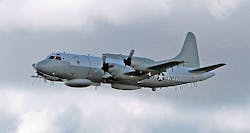Raytheon to provide long-range multi-spectral sensors for Navy long-range reconnaissance aircraft
CRANE, Ind., 30 June 2014.Electro-optics designers at the Raytheon Co. Space and Airborne Systems segment in McKinney, Texas, will build advanced multi-spectral sensors for U.S. Navy long-range reconnaissance aircraft under terms of a $19.7 million contract modification announced late Friday.
Officials of the Naval Surface Warfare Center in Crane, Ind., are asking Raytheon to produce MTS-C Multi-Spectral Targeting Systems and spare parts for Navy Special Projects Aircraft (SPA) -- a secretive version of the P-3 maritime patrol four-engine turboprop outfitted for sensitive surveillance missions.
The Raytheon MTS-C -- a member of the company's multi-spectral targeting systems family -- is an airborne, electro-optic, forward-looking, infra-red, turreted sensor system which provides long-range surveillance to support the Navy SPA mission.
The MTS-C provides high-altitude target acquisition, tracking, range-finding, and laser designation, and can provide guidance for all tri-service and NATO laser-guided munitions.
Related: Raytheon moves toward full production of upgraded multispectral avionics targeting sensor
The Navy's Special Projects Aircraft typically operate over Afghanistan and other parts of the world carrying. They are outfitted with classified signals intelligence, radar, optical, and intelligence (MASINT) sensors.
The MTS equips aircraft such as the SPA, C-130 utility turboprop, SH-60 helicopters, Predator drones, and several other aircraft types with an electro-optical and infrared full-motion video camera system that permits long-range surveillance and high-altitude acquisition, tracking and laser designation.
The Raytheon MTS family of turreted sensors can be fitted with multiple wavelength sensors, near-infrared and color TV cameras, illuminators, eyesafe rangefinders, image merging, spot trackers, and other avionics.
The multi-use system offers surveillance, target acquisition, tracking, rangefinding, and laser designation for the Hellfire missile and for all tri-service and NATO laser-guided munitions such as the Paveway Laser Guided Bomb. The Advanced Targeting Forward Looking Infrared (ATFLIR) pod also is used with Paveways, JSOWs and HARMs, Raytheon officials say.
Related: Raytheon to provide UAV electro-optical targeting systems in $50.2 million contract
To ensure operational reliability, the MTS was designed to meet environmental testing extremes. Its advanced electronics and optical design allow for capability and performance enhancements through add-in circuitry.
One of the world’s most advanced integrated EO/IR systems, the MTS-C includes a long-wave infrared detector, which is suitable for tracking cold bodies such as missiles and warheads after boost phase, as well as or plumes and exhaust of missiles and rockets during boost phase.
On this contract Raytheon will do the work in McKinney, Texas, and should be finished by May 2016. For more information contact Raytheon Space and Airborne Systems online at www.raytheon.com, or the Naval Surface Warfare Center-Crane at www.navsea.navy.mil/nswc/crane.

